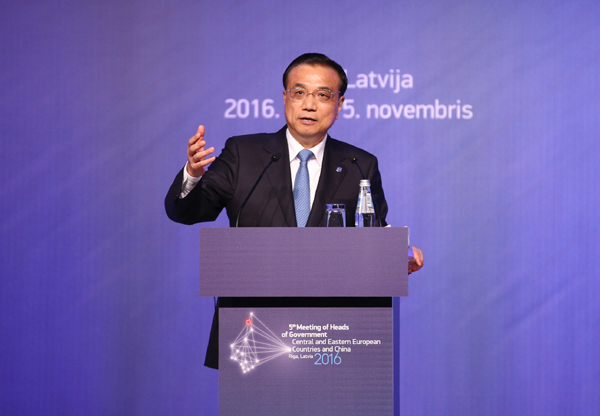The rise of the Eurasian silk road
Updated: 2016-11-08 15:04
By Dan Steinbock (chinadaily.com.cn)
|
|||||||||
|
 |
|
Chinese Premier Li Keqiang speaks at a news conference in the National Library in Riga, Latvia, Nov 5, 2016. [Photo provided to chinadaily.com.cn] |
Premier Li’s Eurasian tour heralds the new future of Eurasia that will be based on regional economic integration.
Last Wednesday, Premier Li Keqiang began a week-long trip in Kyrgyzstan, Kazakhstan, Russia and Latvia seeking to promote China’s relations with the four countries, and boosting regional development and cooperation.
Interestingly, it was one of those multinational visits that was left in the dark by the Western media. Yet, Premier Li’s visits precipitate increasing economic, political and security cooperation in a world region that leading US strategic thinkers have historically considered critical to “American primacy”; that is, US global hegemony.
US security doctrines contend that no Eurasian challengers should emerge capable of dominating Eurasia. In reality, Eurasia wants peace and prosperity, not dominance and hegemony.
The rise of Eurasian Economy
During his tour, Premier Li also attended the Shanghai Cooperation Organization’s (SCO) 15th prime ministers’ meeting in Bishkek, the Kyrgyz capital, and the fifth leaders’ meeting of China and Central and Eastern European (CEE) countries in Riga. In the Latvian capital, he proposed four principles to guide ‘16+1’ cooperation: mutual respect and assistance, win-win cooperation, openness and inclusiveness, and joint development.
From the Eurasian perspective, Premier Li’s visit continues to pave the way to regional cooperation in Eurasia and economic integration within the Eurasian Economic Union (EAEU). In January last year, the EAEU was signed by Belarus, Kazakhstan and Russia, with further accession treaties by Kyrgyzstan and Armenia.
The five EAEU nations represent an integrated single market of more than 180 million people and a GDP of $1.5 trillion; the economic size of Canada or South Korea, respectively. While Russia dominates more than 85 per cent of the total, the Union’s real importance is that through economic integration it will ensure peace and economic cooperation between the member countries.
From the Chinese perspective, the four countries - Kyrgyzstan, Kazakhstan, Russia and Latvia - are all located along the ancient Silk Road. Indeed, Li’s tour sought to foster the joint implementation of China’s One Road One Belt (OBOR) initiative.
It is the modern restoration of the trade, logistics and infrastructure network that will connect East, South and Southeast Asia with Central Asia, the Middle East and North Africa, through Central and Eastern Europe to Western Europe.
Today's Top News
Europe would elect Clinton: Poll
UK 'will stick to planned EU departure plan'
UK PM May promises EU exit 'in full'
Chinese dance drama stuns British audience
China adopts interpretation to Basic Law of HK SAR
Latvia links with Belt and Road Initiative
High Court: Parliament must vote before Brexit
Li promotes SCO bank, free trade
Hot Topics
Lunar probe , China growth forecasts, Emission rules get tougher, China seen through 'colored lens', International board,
Editor's Picks

|

|

|

|

|

|







